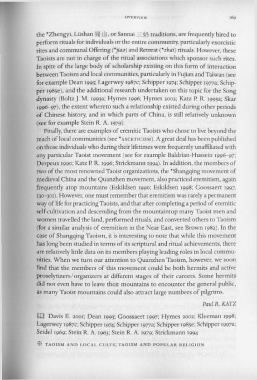Page 209 - The Encyclopedia of Taoism v1_A-L
P. 209
OVERV I EW
the *Zhengyi, Liishan Im ill, or Sannai =.YJ] traditions, are frequently hired to
perform rituals for individuals or the entire community, particularly exorcistic
rites and communal Offering (*jiao) and Retreat (*zhai) rituals. However, these
Taoists are not in charge of the ritual associations which sponsor such rites.
In spite of the large body of scholarship existing on this form of interaction
between Taoism and local communities, particularly in Fujian and Taiwan (see
for example Dean 1993; Lagerwey 1987C; Schipper 1974; Schipper 1977a; Schip-
peor 198se), and the additional research undertaken on this topic for the Song
dynasty (Boltz J. M. 1993a; Hymes 1996; Hymes 2002; Katz P. R. 199sa; Skar
1996-97), the extent whereto such a relationship existed during other periods
of Chinese history, and in which parts of China, is still relatively unknown
(see for example Stein R. A. 1979).
Finally, there are examples of eremitic Taoists who chose to live beyond the
reach of local communities (see * ASCETICISM) . A great deal has been published
on those individuals who during their lifetimes were frequently unaffiliated with
any particular Taoist movement (see for example Baldrian-Hussein 1996-97;
Despeux 1990; Katz P. R. 1996; Strickmann 1994). In addition, the members of
two of the most renowned Taoist organizations, the *Shangqing movement of
medieval China and the Quanzhen movement, also practiced eremitism, again
frequently atop mountains (Eskildsen 1990; Eskildsen 1998; Goossaert 1997,
130-301). However, one must remember that eremitism was rarely a permanent
way of life for practicing Taoists, and that after completing a period of eremitic
self-cultivation and descending from the mountaintop many Taoist men and
women travelled the land, performed rituals, and converted others to Taoism
(for a similar analysis of eremitism in the Near East, see Brown 1982). In the
case of Shangqing Taoism, it is interesting to note that while this movement
has long been studied in terms of its scriptural and ritual achievements, there
are relatively little data on its members playing leading roles in local commu-
nities. When we turn our attention to Quanzhen Taoism, however, we soon
find that the members of this movement could be both hermits and active
proselytizers / organizers at different stages of their careers. Some hermits
did not even have to leave their mountains to encounter the general public,
as many Taoist mountains could also attract large numbers of pilgrims.
PaulR. KATZ
ID Davis E. 2001; Dean 1993; Goossaert 1997; Hymes 2002; Kleeman 1998;
Lagerwey 1987C; Schipper 1974; Schipper 1977a; Schipper 198se; Schipper 1997a;
Seidel 1969; Stein R. A. 1963; Stein R. A. 1979; Strickmann 1994
* TAOISM AND LOCAL CULTS ; TAOISM AND POPULAR RELIGION

